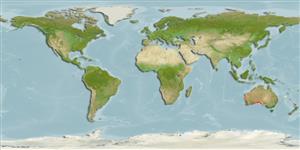>
Perciformes/Scorpaenoidei (Scorpionfishes) >
Pataecidae (Australian prowfishes)
Etymology: Pataecus: Pataeco, a dwarf like Phoenician god. Refers to the likeness of this species to the image of gods on the bows of ancient sailing vessels (Ref. 45335).
More on author: Richardson.
Environment: milieu / climate zone / depth range / distribution range
Ekologi
marina bottenlevande; djupintervall 40 - 80 m (Ref. 9563). Subtropical; 25°S - 36°S
Indo-Pacific: endemic to Australia (Shark Bay, Western Australia (25°21'S) to South Australia and from Moreton Bay, Queensland (27°25'S) to Durras, New South Wales (35°15'S)).
Size / Vikt / Age
Maturity: Lm ? range ? - ? cm
Max length : 27.0 cm TL hane/ej könsbestämd; (Ref. 9563)
Occurs on the continental shelf (Ref. 9563, 75154). Benthic (Ref. 75154).
Life cycle and mating behavior
Maturities | Reproduktion | Spawnings | Egg(s) | Fecundities | Larver
May, J.L. and J.G.H. Maxwell, 1986. Trawl fish from temperate waters of Australia. CSIRO Division of Fisheries Research, Tasmania. 492 p. (Ref. 9563)
IUCN Red List Status (Ref. 130435)
Threat to humans
Harmless
Human uses
Verktyg
Special reports
Download XML
Internet-källor
Estimates based on models
Preferred temperature (Ref.
123201): 16.6 - 22.5, mean 17.6 °C (based on 29 cells).
Phylogenetic diversity index (Ref.
82804): PD
50 = 1.1250 [Uniqueness, from 0.5 = low to 2.0 = high].
Bayesian length-weight: a=0.00389 (0.00180 - 0.00842), b=3.12 (2.94 - 3.30), in cm total length, based on all LWR estimates for this body shape (Ref.
93245).
Trofisk nivå (Ref.
69278): 3.7 ±0.4 se; based on size and trophs of closest relatives
Fishing Vulnerability (Ref.
59153): Low vulnerability (17 of 100).
